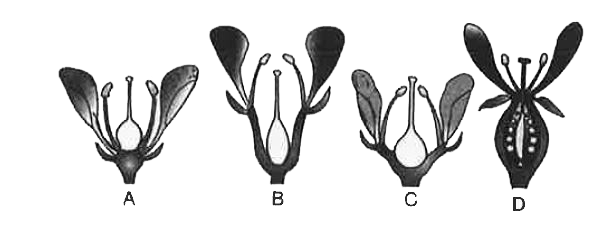Choose the correct set of disease transmitting arthropods
Tsetse fly, house fly, rat flea, sand fly
Anopheles, louse, house fly, termite
Cockroach, louse, termite, housr fly
Rat flea, butterfly, house fly, tse-tse fly.
The correct Answer is:A
To solve the question regarding the correct set of disease-transmitting arthropods, we will analyze each option provided and identify which arthropods act as vectors for diseases.
1. Identify the Arthropods in Each Option:
- Look at the list of arthropods provided in each option. Common vectors include flies, fleas, and other insects.
2. Research Each Arthropod's Role as a Vector:
- C. C. Fly (Tsetse Fly): This is known to transmit *Trypanosoma gambiense*, which causes sleeping sickness.
- Housefly: This insect is a vector for various diseases, including typhoid fever and amoebic dysentery, primarily through contaminated food and water.
- Rat Flea (Xenopsylla): This flea is a vector for the bubonic plague.
- Sand Fly (Phlebotomus): This fly transmits *Leishmania donovani*, which causes Kala Azhar (Dum-Dum Fever).
3. Evaluate Each Option:
- Option 1: C. C. Fly, Housefly, Rat Flea, Sand Fly.
- All these arthropods are known vectors for diseases.
- Option 2: Anopheles (malaria), Louse (typhus fever), Housefly, Termite.
- Anopheles and Louse are vectors, but Termite is not a vector.
- Option 3: Cockroach, Housefly, Termite, Rat Flea.
- Cockroaches can contaminate food but are not considered primary disease vectors, and Termite is not a vector.
- Option 4: Butterfly, Housefly, Rat Flea, Sand Fly.
- Butterfly is primarily a pollinator and does not transmit diseases.
4. Select the Correct Option:
- After evaluating all options, Option 1 is the only set where all arthropods listed are confirmed vectors for diseases.
Final Answer:
The correct set of disease-transmitting arthropods is Option 1: C. C. Fly, Housefly, Rat Flea, and Sand Fly.
---
- Look at the list of arthropods provided in each option. Common vectors include flies, fleas, and other insects.
- C. C. Fly (Tsetse Fly): This is known to transmit *Trypanosoma gambiense*, which causes sleeping sickness.
- Housefly: This insect is a vector for various diseases, including typhoid fever and amoebic dysentery, primarily through contaminated food and water.
- Rat Flea (Xenopsylla): This flea is a vector for the bubonic plague.
- Sand Fly (Phlebotomus): This fly transmits *Leishmania donovani*, which causes Kala Azhar (Dum-Dum Fever).
- Option 1: C. C. Fly, Housefly, Rat Flea, Sand Fly.
- All these arthropods are known vectors for diseases.
- Option 2: Anopheles (malaria), Louse (typhus fever), Housefly, Termite.
- Anopheles and Louse are vectors, but Termite is not a vector.
- Option 3: Cockroach, Housefly, Termite, Rat Flea.
- Cockroaches can contaminate food but are not considered primary disease vectors, and Termite is not a vector.
- Option 4: Butterfly, Housefly, Rat Flea, Sand Fly.
- Butterfly is primarily a pollinator and does not transmit diseases.
- After evaluating all options, Option 1 is the only set where all arthropods listed are confirmed vectors for diseases.
The correct set of disease-transmitting arthropods is Option 1: C. C. Fly, Housefly, Rat Flea, and Sand Fly.
Topper's Solved these Questions
- PHYLUM - ARTHROPODABOOK - DINESH PUBLICATION ENGLISHCHAPTER - PHYLUM - ARTHROPODAEXERCISE - CYG
20 Videos
- PHYLUM - ANNELIDABOOK - DINESH PUBLICATION ENGLISHCHAPTER - PHYLUM - ANNELIDAEXERCISE - Check your grasp
10 Videos
- PLANT BREEDING AND DISEASE CONTROLBOOK - DINESH PUBLICATION ENGLISHCHAPTER - PLANT BREEDING AND DISEASE CONTROLEXERCISE - Check your Grasp
10 Videos
Similar Questions
Knowledge Check
Multiple choice questions (MCQs)
choose the correct option
Chancroid is a sexually transmitted disease caused byATreponemaBHaemophilusCNSSCHDTrichomonas
Helmintic diseases are transmitted through
View SolutionCleavage in arthropods is
View SolutionArthropods lack
View SolutionArthropods lack
View SolutionThe viviparous arthropod is
View Solution(a) Name the Protozoan parasite that causes amoebic dysentery in humans.
(b) Mention two diagnostic symptoms of the disease.
(c) How is this disease transmitted to others?
View SolutionZoonotic disease transmitted to humans is
View Solution
